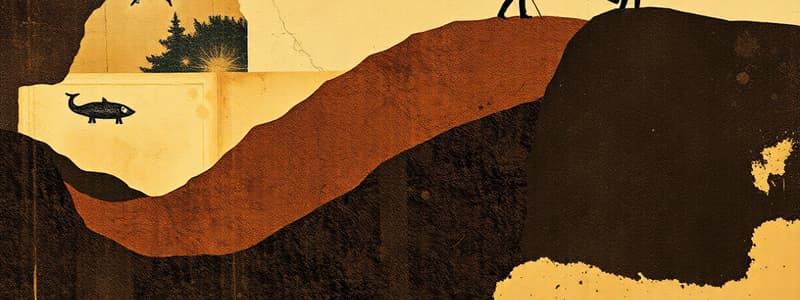Podcast
Questions and Answers
What is the primary role of the 25% water content within healthy soil composition?
What is the primary role of the 25% water content within healthy soil composition?
- To contribute directly to the soil's structural integrity by forming a hardpan layer.
- To act as a solvent, enabling plants to absorb essential nutrients. (correct)
- To increase soil temperature, promoting chemical weathering processes.
- To facilitate gaseous exchange, providing oxygen to plant roots.
How does the soil composition typically differ between highland and lowland areas in Ireland?
How does the soil composition typically differ between highland and lowland areas in Ireland?
- Both highland and lowland soils exhibit similar characteristics due to Ireland's temperate climate.
- Lowland soils are cold, wet, waterlogged, and have little life or humus.
- Highland soils are generally deeper and well-drained, with abundant life and humus.
- Highland soils tend to be cold, wet, waterlogged, with limited life and humus, whereas lowland soils are deeper and well-drained, supporting more life and humus. (correct)
What is the most significant impact of 'time' as a factor affecting soil formation?
What is the most significant impact of 'time' as a factor affecting soil formation?
- Time dictates the types of plants that can grow in the soil.
- Time influences the temperature of the soil alone..
- Time determines the amount of air and water present in the soil.
- Time correlates with the extent to which parent rock weathers and breaks down. (correct)
In a typical soil profile, which horizon is characterized by partially weathered parent rock located above the bedrock?
In a typical soil profile, which horizon is characterized by partially weathered parent rock located above the bedrock?
Which characteristic most accurately describes Gley soil and its limitations for agricultural use?
Which characteristic most accurately describes Gley soil and its limitations for agricultural use?
Flashcards
What is soil?
What is soil?
The thin, uppermost layer of the Earth's surface, composed of mineral particles, air, water, and humus.
Factors affecting soil formation?
Factors affecting soil formation?
Temperature, time, and location.
What is a soil profile?
What is a soil profile?
A vertical section of soil showing distinct layers (horizons).
What are soil horizons?
What are soil horizons?
Signup and view all the flashcards
Types of Irish soil?
Types of Irish soil?
Signup and view all the flashcards
Study Notes
- Soil is the thin, uppermost layer of the earth.
- Soil composition is 45% mineral particles, 25% air, 25% water, and 5% humus.
- Mineral particles like sand and clay affect the soil's permeability.
- Air found in soil pores provides oxygen and nitrogen to plants and organisms.
- Water holds the soil together and enables nutrient uptake by plant roots.
Factors Affecting Soil
- Temperature affects how parent rock breaks down; hot climates experience chemical weathering, while cold climates experience freeze-thaw action.
- Highland areas have cold, wet, waterlogged soil with little life and humus.
- Lowland areas have deeper, well-drained soil with more life and humus.
- Time is the most important factor: the longer rock is exposed to weathering, the more it breaks down.
Soil Profile
- A soil profile is a vertical section of soil with layers called horizons.
- The A horizon is topsoil which is loose and crumbly.
- The B horizon is subsoil, containing stones and is protected from weathering.
- The C horizon consists of partially weathered parent rock above the bedrock.
Soils of Ireland
- Brown soil is the most common in Ireland, found in areas with limited rain and deciduous forests like the Midlands.
- Podzol soils are found in highland areas with more rain; they are grey due to hardpan blocking water and nutrients.
- Podzol soils are typically found in coniferous forests and contain little humus.
- Gley soil forms on gently sloping hills and is blue-grey in color.
- Gley soil is very thin, floods easily, and is not very fertile.
- Peaty soil, also called bogland, takes thousands of years to form.
- Peaty soil is dark, heavily waterlogged, and not very fertile.
Studying That Suits You
Use AI to generate personalized quizzes and flashcards to suit your learning preferences.
Description
Explore soil composition, including mineral particles, air, water, and humus. Learn about factors like temperature, altitude, and time that influence soil formation. Understand the soil profile, including topsoil (A horizon) and subsoil (B horizon).



